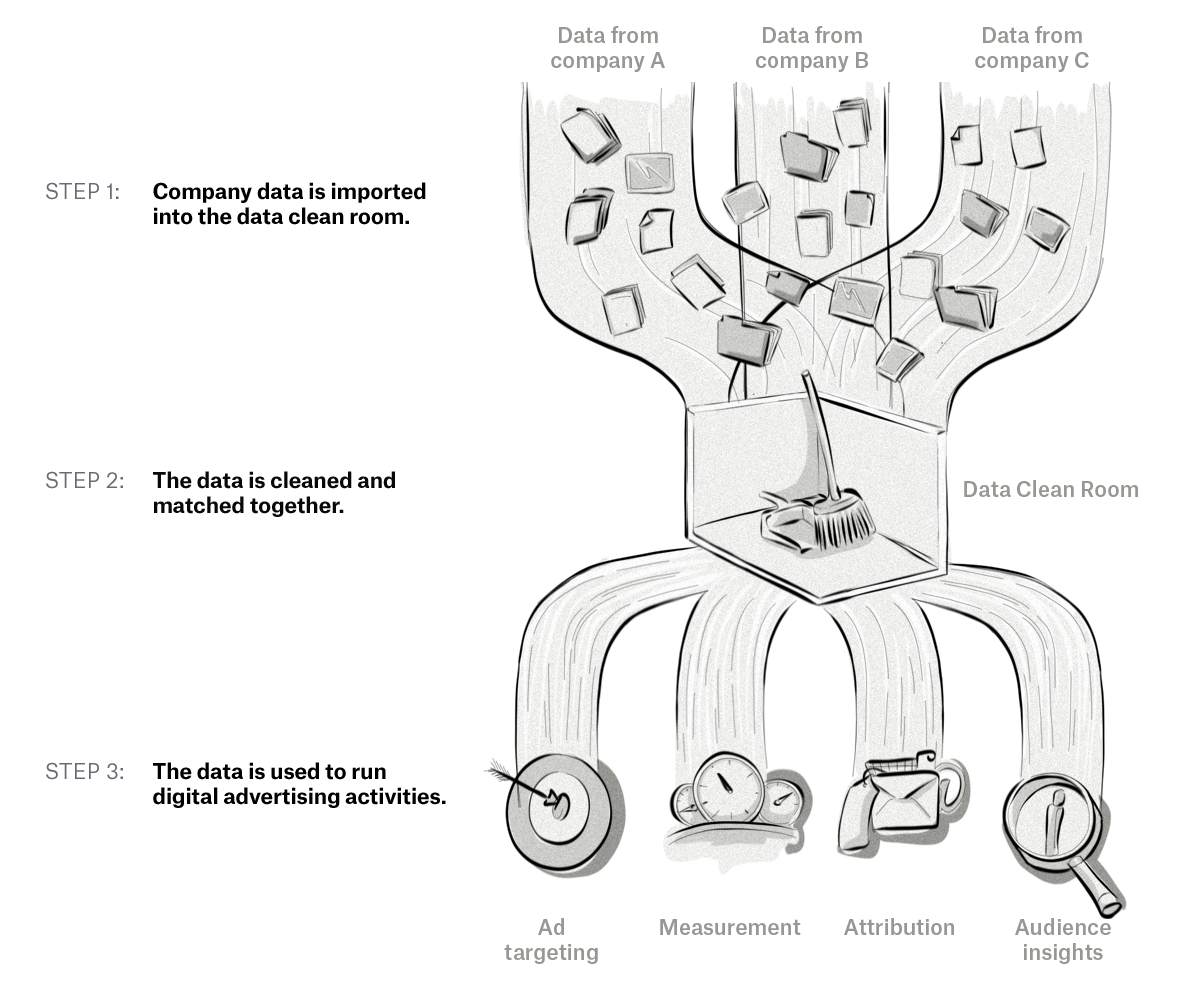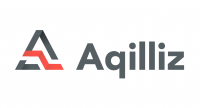Third-party cookies were the main mechanism for identifying individuals across different websites for the purpose of showing them personalized ads, running frequency capping, measuring the performance of campaigns, and performing attribution.
But as we all know, third-party cookies are not very privacy-friendly and are being shut off, one web browser at a time.
Apple’s Safari and Mozilla’s Firefox already blocked third-party cookies by default and Google Chrome will be shutting off support for them in 2023.
So how can advertisers still run personalized ads, measurement, and attribution without third-party cookies while still ensuring a certain level of user privacy protection?
Various solutions to this problem have emerged, with data clean rooms being one of the main ones.
In this blog post, we explain what data clean rooms are, how they work, the pros and cons of them, and why some brands are building their own.
Watch the video interview below with Gowthaman Ragothaman, CEO at Aqilliz, a data clean room provider.
What Is a Data Clean Room?
A data clean room is a piece of software that allows brands and advertisers to run targeted advertising campaigns, apply frequency capping, measure and report on the performance of campaigns, and run attribution — all in a privacy-friendly way. They can achieve this by uploading their first-party data and comparing it to the aggregate data in the data clean room, which has also been added by other companies.
Unlike other types of data partnerships whereby companies directly exchange user-level data, such as cookie IDs, device IDs, and IDs created from hashed email addresses, data clean rooms match the first-party data provided by brands and advertisers together but prevent any user-level data from being accessed outside of the data clean room. All of the first-party and user-level data stays within the data clean room and isn’t shared with anyone else.
How Does a Data Clean Room Work?
The first step involves companies adding their first-party data to the data clean room. In the next step, various security and privacy-protection measures are applied to the data, such as pseudonymization, restricted access, differential privacy and noise injection. The third phase involves placing the data into cohorts.
The data can then be activated — i.e. used for various advertising and marketing processes such as targeting, measurement, and audience analysis.
Advertisers and publishers can analyze reports provided by the data clean room to improve the campaigns they are currently running or will run in the future.
To understand how data clean rooms work, think of a metal box traveling along a one-way conveyor belt. Using this analogy, here’s how the process works:
- Loading
Advertisers put a package of their first-party data on the belt. The package can contain user-level data as well as transactional and historical data. On the other side of the belt, another advertiser or publisher places their package of first-party data on the belt.
- Cleaning
The belt takes packages to the metal box, which is the data clean room. In that box, the data from the two parties is matched and cleaned — i.e. audiences are matched and privacy techniques such as encryption, hashing, pseudonymization, restricting access, and noise injection are applied.
- Ready to use
From there, you can show ads to members of your target audience and receive reports, which you can then analyze and utilize for other advertising-related activities.
Because privacy is the key focus of a data clean room, you’ll receive reports based on aggregated data. So you’ll know how many people clicked on one of your ads, but you won’t know anything about them, e.g. you won’t receive user-level data such as IDs.
We Can Help You Build a Data Clean Room
Our AdTech development teams can work with you to design, build, and maintain a custom-built data clean room for any programmatic advertising channel.
The Main Use Cases Of a Data Clean Room
The various privacy changes in web browsers and mobile apps, as well as new privacy laws, are creating a better world for consumers and Internet users, but are making it harder to run digital advertising activities that companies have relied on in the past. Data clean rooms offer a good balance between protecting user privacy and allowing companies to reach their target audience, measure the performance of their campaigns, and attribute impressions and clicks to conversions.

A data clean room can also allow companies to establish co-marketing partnerships by identifying the customers they share with each other and create more detailed user profiles by analyzing the anonymized reports.
The Pros, Cons And Risks Of Using a Data Clean Room
As with every piece of technology, data clean rooms have both positive and negative sides.
The pros of using a data clean room:
- A privacy-friendly solution for analyzing audiences, targeting ads, and measuring performance. Even though user-level data is added to a data clean room, it’s not exposed to other companies.
- Some data clean rooms deliver a holistic view of the performance of campaigns across various distribution channels.
- The data added to a data clean room is not shared with other companies, allowing the data owners to maintain control of it.
The cons of using data clean room:
- Aggregated data for reporting and ad targeting will be less accurate than ID-based data.
- Before you can upload the data to a data clean room it has to be unified into one format in order to use it.
- A reluctance to share first-party and transactional data may adversely affect the overall effectiveness of a data clean room and the various functions it can carry out for the companies that use it.
- Many data clean rooms work for a specific platform (e.g., Google or Facebook). This means advertisers are forced to manually combine results from different data clean rooms.
- Because data clean rooms are fairly new tools, there are no universal standards for their implementation yet.
The risks of using a data clean room:
- To generate insights, advertisers have to hand over their valuable first-party data. In the worst possible scenario, a data breach could lead to hefty fines, not to mention reputation and clients loss.
- Manually managed data clean rooms are vulnerable to human errors, such as granting access to people who shouldn’t have it, incorrectly formulating queries and exchanging data in an unsecured environment.
- Different organizations have to create different levels of security in order to uphold privacy. The types of data added to a data clean room can vary depending on factors, such as:
- The industry and vertical: There is more vulnerable data in the healthcare industry compared to the automotive industry.
- The appetite for sharing customer data: One company may be willing to ingest all of their customer data into a data clean room while another may only add half of their customer data.
Despite the cons and risks of using data clean rooms, they offer a very promising solution to the current challenges facing the programmatic advertising industry, i.e. running advertising processes, such as ad targeting and measurement, in a privacy-friendly way.
Watch the video interview below with Juan Baron, Director Business Development & Strategy (media & adv) at Decentriq, a data clean room provider.
What’s The Difference Between a CDP And a Data Clean Room?
Both advertisers and publishers collect valuable first-party data from different sources. To help them collect and manage this data, they can use a custom data platform (CDP). A data clean room extends the capabilities of a CDP and takes data management to the next level.
But what are the main differences between a CDP and a data clean room?
- A CDP allows you to collect, share and process first-party, but you are focused on user-level data and IDs. With data clean rooms, the focus is on using anonymized first-party data.
- A CDP with basic security levels (e.g. granting access) is more prone to data leakage compared to high levels of security in a data clean room as the data is anonymized using various data-security techniques.
- You can’t analyze data from other companies in a CDP, but with a data clean room, you can get anonymized reports based on aggregated data, which you can extract insights from.
What Are the Privacy Alternatives to Data Clean Rooms?
The availability of third-party cookies has been on the decline for a few years now and when Google Chrome, the world’s most popular web browser, announced that it would be shutting off support for third-party cookies, various alternatives, such as data clean rooms, started to appear.
There are essentially three main alternatives to a data clean room:
- Universal IDs: Although third-party cookies are dying off, programmatic advertising’s reliance on IDs is not. Universal IDs have emerged as a replacement for third-party cookies, whereby email addresses are used to create hashed IDs. Learn more about various ID solutions here.
- Google Chrome’s Privacy Sandbox: A number of standards focused on better protecting user privacy while at the same time allowing advertisers and publishers to run, measure, and report on programmatic advertising campaigns. The newest standard, Topics API, is a standard that allows advertisers to show ads to users based on the topics they’re interested in.
- Contextual ad targeting: This was the first ad-targeting method available when the online advertising began back in 1994 and thanks to the changing privacy landscape, it’s making a comeback. Contextual targeting allows advertisers to show ads to users based on the context of the page or mobile app. While this may sound like a very primitive targeting method, it can actually be quite effective and can even be enhanced by using other pieces of data from the publisher.
There are also many other alternatives that could be explored in the future, such as cryptoidentities, which aim to represent people via avatars. The technology enables matching, acquiring, and testing data without sharing personally identifiable information (PII).
Which Companies Offer Data Clean Rooms?
There are three kinds of data clean rooms. The first kind is provided by the walled gardens of AdTech, the second kind is provided by independent companies, and the third is owned by companies with huge amounts of users and content.
What’s the difference between them?
With the first kind, Google, Amazon, and Facebook run media clean rooms where each company delivers hashed and aggregated data to companies that use their advertising platforms.
In the second case, two data owners, e.g. a publisher and an advertiser, put their data into one neutral room and share it safely between one another.
And in the third case, companies that have massive amounts of user data and content, such as Disney, Spotify, and TikTok, build their own data clean rooms.
Let’s now look at some examples of companies that offer data clean rooms.
Decentriq

Known as the “Switzerland of Data”, Decentriq is a data clean room and data collaboration platform. Decentriq’s technology is built using the latest advancements in encryption and Privacy Enhancing Technologies such as synthetic data, differential privacy, and Confidential Computing. The Decentriq platform is used by companies from various industries, including media and advertising, healthcare, and banks.
Google Ads Data Hub

Google Ads Data Hub is a privacy-safe data warehousing solution built on Google Cloud. It provides the tools to create custom reports that don’t contain personally identifiable information (PII). The sources of data come from Google Campaign Manager, Display & Video 360 (DV360), Google Ads, and YouTube.
Amazon Marketing Cloud (AMC)

Amazon Marketing Cloud (AMC) is a holistic data clean room solution built on Amazon Web Services. It helps companies discover the true impact of cross-media investments by matching and analyzing two sources of data: advertiser’s data sets and data sets delivered by Amazon Advertising events.
InfoSum

InfoSum created a privacy-enhancing environment with the utmost respect for the safety of data. The mechanisms behind InfoSum’s data clean room process the data in a fully decentralized and cloud-agnostic room which eliminates all the data-leakage risks related to centralized data lakes or warehouses.
Snowflake

With Snowflake, advertising companies can build an environment capable of processing shared data sets. Snowflake’s clean rooms provide real-time information and hide customers’ personal information at the same time.
Aqilliz

Aqilliz offers a new-age middleware technology for the currently disjointed digital marketing ecosystem. Rooted in the pillars of differential privacy and federated learning on a distributed ledger, Aqilliz benefits brands, platforms, and consumers alike by delivering collaboration solutions that ensure a privacy-compliant approach to insights, activation, and measurement, leading to better productivity.
Disney Advertising Sales

Disney Advertising Sales introduced its clean room in 2021. The cloud-agnostic solution is powered by Disney Select data and Disney Advertising’s Audience Graph. The key strategic cloud collaborators are Habu, InfoSum and Snowflake.
Why Are Brands Using (and Building) Data Clean Rooms?
We’ve observed three different trends around building data clean rooms, with the retail sales sector being one of the most adaptive.
Hershey’s Aims to Gather Loyalty Card Data from Retailers
Hershey’s is an example of a company that seeks to evolve its advertising strategy and gather new insights about the performance of its ad campaigns. The candy maker sells its products throughout a network of retailers but lacks insights into certain key areas of its business, e.g. the effectiveness of its loyalty programs.
By building their own data clean room, Hershey’s can convince retailers to share their first-party data with the producer, check the volume of repeated ads, analyze loyalty programs, and choose the right direction for their advertising activities. The retailers store loyalty-card data alongside Hershey’s ad data and share data sets in Hershey’s data clean room.
Unilever Approaches to Solve Cross-Platform Measurement Issues
Unilever is using a data clean room to identify the platforms where ad content was shown to the same user and didn’t result in a positive retail effect. The company does this by sending its ad-related records and data sets to measurement companies Nielsen and Kantar and then analyzing the results across platforms like Google, Facebook and Twitter.
Disney Improves Advertising
Disney introduced its data clean room solution as a way to provide custom and future-forward solutions to marketers. By partnering with data clean vendors Habu, InfoSum, and Snowflake, Disney is able to offer their advertising clients a privacy-friendly way to reach Disney’s audience and obtain valuable consumer insights.
Conclusion
Due to the upcoming end of third-party cookies in Google Chrome, businesses are looking for ways to continue their advertising processes, such as ad targeting and measurement, while respecting users’ privacy at the same time.
Data clean rooms are one of the solutions to tackle the problem. To use a data clean room, two entities (e.g. an advertiser and a publisher) prepare packages of data and upload them to the data clean room. Then, the data is encrypted and anonymized. Both parties get information in the form of cohorts and aggregated reports.
Data clean rooms are mostly used for ad targeting and personalization, frequency capping, measurement, and attribution purposes.
Of course, there are also other alternatives, such as universal user IDs, Google Privacy Sandbox, and contextual targeting.
The data clean room market is rapidly growing and accelerating as the end of third-party cookies gets closer. There are three types of data clean rooms; ones offered by the walled gardens (Google, Meta and Amazon), ones from independent vendors, and custom-made ones built by brands and content owners.
We Can Help You Build a Data Clean Room
Our AdTech development teams can work with you to design, build, and maintain a custom-built data clean room for any programmatic advertising channel.







